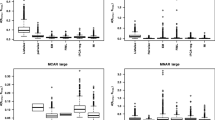Abstract
Models for missing data are necessarily based on untestable assumptions whose effect on the conclusions are usually assessed via sensitivity analysis. To avoid the usual normality assumption and/or hard-to-interpret sensitivity parameters proposed by many authors for such purposes, we consider a simple approach for estimating means, standard deviations and correlations. We do not make distributional assumptions and adopt a pattern-mixture model parameterization which has easily interpreted sensitivity parameters. We use the so-called estimated ignorance and uncertainty intervals to summarize the results and illustrate the proposal with a practical example. We present results for both the univariate and the multivariate cases.
Similar content being viewed by others
References
Allison PD (2001) Missing data. Sage, Thousand Oaks
Daniels MJ, Hogan JW (2000) Reparameterizing the pattern mixture model for sensitivity analyses under informative dropout. Biometrics 56:1241–1248
Daniels MJ, Hogan JW (2007) Missing data in longitudinal studies: strategies for Bayesian modeling and sensitivity analysis. Chapman & Hall, London
Efron B, Gong G (1983) A leisure look at the bootstrap, the jackknife and cross-validation. Am Stat 37:36–48
Fitzmaurice G, Davidian M, Verbeke G, Molenberghs G (2008) Longitudinal data analysis. Chapman & Hall, Boca Raton
Glynn RJ, Laird NM, Rubin DB (1986) Selection modeling versus mixture modeling with nonignorable nonresponse (with discussion). In: Wainer H (ed) Drawing inferences from self-selected samples. Erlbaum, Mahwah, pp 115–151
Grab EL, Savage IR (1954) Tables of the expected value of 1/X for positive Bernoulli and Poisson variables. J Am Stat Assoc 49:169–177
Hyndman RJ, Fan Y (1996) Sample quantiles in statistical packages. Am Stat 50:361–365
Kenward MG, Goetghebeur E, Molenberghs G (2001) Sensitivity analysis for incomplete categorical data. Stat Model 1:31–48
Little RJA (1994) A class of pattern-mixture models for normal incomplete data. Biometrika 81:471–483
Little RJA, Rubin DB (2002) Statistical analysis with missing data, 2nd edn. Wiley, New York
Little RJA, Wang YX (1996) Pattern-mixture models for multivariate incomplete data with covariates. Biometrics 52:98–111
Mendenhall W, Lehman JEH (1960) An approximation to the negative moments of the positive binomial useful in life testing. Technometrics 2:227–242
Molenberghs G, Kenward MG (2007) Missing data in clinical studies. Wiley, New York
Molenberghs G, Kenward MG, Goetghebeur E (2001) Sensitivity analysis for incomplete contingency tables: the Slovenian plebiscite case. Appl Stat 50:15–29
Poleto FZ, Paulino CD, Molenberghs G, Singer JM (2010) Inferential implications of over-parameterization: a case study in incomplete categorical data. Tech rep, RT-MAE-2010-04, Instituto de Matemática e Estatística, Universidade de São Paulo
Rotnitzky A, Robins JM, Scharfstein DO (1998) Semiparametric regression for repeated outcomes with nonignorable nonresponse. J Amer Stat Assoc 93:1321–1339
Rotnitzky A, Scharfstein D, Su TL, Robins JM (2001) Methods for conducting sensitivity analysis of trials with potentially nonignorable competing causes of censoring. Biometrics 57:103–113
Rubin DB (1976) Inference and missing data. Biometrika 63:581–592
Rubin DB (1977) Formalizing subjective notions about the effect of nonrespondents in sample surveys. J Am Stat Assoc 72:538–543
Scharfstein DO, Rotnitzky A, Robins JM (1999) Adjusting for nonignorable drop-out using semiparametric nonresponse models (with discussion). J Am Stat Assoc 94:1096–1146
Scharfstein DO, Daniels MJ, Robins JM (2003) Incorporating prior beliefs about selection bias into the analysis of randomized trials with missing outcomes. Biostatistics 4:495–512
Sen PK, Singer JM, Pedroso de Lima AC (2009) From finite sample to asymptotic methods in statistics. Cambridge University Press, Cambridge
Silverman BW (1986) Density estimation, 2nd edn. Chapman & Hall, London
Stephan FF (1945) The expected value and variance of the reciprocal and other negative powers of a positive Bernoullian variate. Ann Math Stat 16:50–61
Vansteelandt S, Goetghebeur E, Kenward MG, Molenberghs G (2006) Ignorance and uncertainty regions as inferential tools in a sensitivity analysis. Stat Sin 16:953–979
Author information
Authors and Affiliations
Corresponding author
Additional information
Communicated by Domingo Morales.
The authors would like to thank the following institutions for financial support: Frederico Z. Poleto and Julio M. Singer, from Coordenação de Aperfeiçoamento de Pessoal de Nível Superior (CAPES), Brazil, Fundação de Amparo à Pesquisa do Estado de São Paulo (FAPESP), Brazil, and Conselho Nacional de Desenvolvimento Científico e Tecnológico (CNPq), Brazil; Geert Molenberghs, from the IAP research Network P6/03 of the Belgian Government (Belgian Science Policy); Carlos Daniel Paulino, from Fundação para a Ciência e Tecnologia (FCT) through the research centre CEAUL-FCUL, Portugal.
Rights and permissions
About this article
Cite this article
Poleto, F.Z., Molenberghs, G., Paulino, C.D. et al. Sensitivity analysis for incomplete continuous data. TEST 20, 589–606 (2011). https://doi.org/10.1007/s11749-010-0219-x
Received:
Accepted:
Published:
Issue Date:
DOI: https://doi.org/10.1007/s11749-010-0219-x




